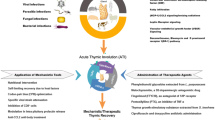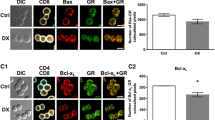Abstract
Tributyltin (TBT) immunotoxicity in rodent species is primarily characterised by T-lymphocyte deficiency resulting from a depletion of cortical thymocytes. In this study, bis(tri-n-butyltin) oxide (TBTO) was administered to male rats as a single oral dose of 30 or 60 mg/kg, and assessments were made of thymic cytopathology and the integrity of cellular DNA. TBTO treatment did not cause severe toxicity or overt clinical signs; however, by 48 h post-dosing relative thymus weights at 30 and 60 mg/kg were reduced to 66 and 43%, respectively, of control values. Increased DNA fragmentation was evident in thymic cell isolates (principally thymocytes) obtained from treated animals during the period of thymic involution. When DNA purified from these cells was visualised by agarose gel electrophoresis a multimeric internucleosomal fragmentation pattern, indicative of supra-physiological levels of apoptosis, was detected. Although unassociated apoptotic or necrotic thymocytes were essentially absent in cell preparations from TBTO-treated rats, significantly increased numbers of mononuclear phagocytic cells were observed. Many of these cells contained either apoptotic thymocytes, with nuclear morphologies exhibiting chromatin condensation, or cell remnants which were characterised as apoptotic bodies. Dibutyltin, which is a major metabolic dealkylation product of tributyltin, failed to significantly stimulate apoptosis when added to isolated thymocytes in vitro. Collectively, these findings suggest that activation of apoptosis contributes to TBT-induced thymocyte depletion in vivo, and indicate that it is unlikely that the metabolite dibutyltin is responsible for this effect.
Similar content being viewed by others
Abbreviations
- TBTO:
-
bis(tri-n-butyltin) oxide
- TBT:
-
tri-n-butyltin
- TBTC:
-
tri-n-butyltin chloride
- DBTC:
-
dibutyltin dichloride
- H33258:
-
2′-(4-hydroxyphenyl)-5-(4-methyl-1-piperizinyl)-2,5′-bi-1H-benzimidazole trihydrochloride
References
Afanas'ev VN, Korol' BA, Matylevich NP, Pechatnikov VA, Umanskii SR (1988) The features of colchicine induced death of lymphoid cells. Tsitologiya 30: 1108–1116
Arends MJ, Wyllie AH (1991) Apoptosis: Mechanisms and roles in pathology. Int Rev Exp Pathol 32: 223–254
Aw TY, Nicotera P, Manzo L, Orrenius S (1990) Tributyltin stimulates apoptosis in rat thymocytes. Arch Biochem Biophys 283: 46–50
Barker EA, Smuckler EA (1973) Nonhepatic thioacetamide injury. I. Thymic cortical necrosis. Am J Pathol 71: 409–418
Blunden SJ, Chapman AH (1982) The environmental degradation of organotin compounds — a review. Environ Tech Lett 3: 267–272
Boyer IJ (1989) Toxicity of dibutyltin, tributyltin and other organotins to humans and to experimental animals. Toxicology 55: 253–298
Burchiel SW, Davis DP, Ray SD, Archuleta MM, Thilsted JP, Corcoran GB (1992) DMBA-induced cytotoxicity in lymphoid and nonlymphoid organs of B6C3F1 mice: relation of cell death to target cell intracellular calcium and DNA damage. Toxicol Appl Pharmacol 113: 126–132
Burton K (1956) A study of the conditions and mechanism of the diphenylamine reaction for the colorimetric estimation of deoxyribonucleic acid. Biochem J 62: 315–323
Compton MM, Cidlowski JA (1986) Rapid in vivo effects of glucocorticoids on the integrity of rat lymphocyte genomic deoxyribonucleic acid. Endocrinology 118: 38–45
De Waal EJ, Rademakers LHPM, Schuurman HJ, Van Loveren H, Vos JG (1991) Atrophy of the rat thymus. Effects of 2,3,7,8-tetrachlorodibenzo-p-dioxin on the epithelial microenvironment assessed at the ultrastructural level: a comparison with bis(tri-nbutyltin) oxide. In: Imhof BA, Berrih-Aknin S, Ezine S (eds) Lymphatic tissues and in-vivo immune responses: Tenth International Conference on lymphatic tissues and germinal centres in immune reactions. Marcel-Decker, New York, pp 117–121
Facchinetti A, Tessarollo L, Mazzocchi M, Kingston R, Collavo D, Biasi G (1991) An improved method for the detection of DNA fragmentation. J Immunol Methods 136: 125–131
Funahashi N, Iwasaki I, Ide G (1980) Effects of bis(tri-n-butyltin) oxide on endocrine and lymphoid organs of male rats. Acta Pathol Jpn 30: 955–966
Humpel M, Kuhne G, Tauber U, Schulze PE (1986) Studies on the kinetics of bis(tri-n-butyl-113tin) oxide (TBTO). In: Toxicology and analytics of the tributyltins — the present status. ORTEP, Berlin, pp 122–142
IPCS, International Programme on Chemical Safety (1990) Environmental Health Criteria 116: Tributyltin compounds. WHO, Geneva
Kerr JFR, Wyllie AH, Currie AR (1972) Apoptosis: a basic biological phenomenon with wide-ranging implications in tissue kinetics. Br J Cancer 26: 239–257
Krajnc EI, Wester PW, Loeber JG, Van Leeuwen FXR, Vos JG, Vaessen HAMG, Van der Heijden CA (1984) Toxicity of bis(tri-n-butyltin) oxide in the rat I. Short-term effects on general parameters and on the endocrine and lymphoid systems. Toxicol Appl Pharmacol 75: 363–386
Krajnc-Franken MAM, Van Loveren H, Schuurman HJ, Vos JG (1990) The immune system as a target for toxicity: a tiered approach to testing, with special emphasis on histopathology. In: Dayan AD, Hertel RF, Heseltine E, Kazantis G, Smith EM, Van der Venne MT (eds) Immunotoxicology of metals and immunotoxicology. Plenum Press, New York, pp 241–264
Penninks AH, Snoeij NJ, Pieters RHH, Seinen W (1990) Effect of organotin compounds on lymphoid organs and lymphoid functions: an overview. In: Dayan AD, Hertel RF, Heseltine E, Kazantis G, Smith EM, Van der Venne MT (eds) Immunotoxicology of metals and immunotoxicology. Plenum Press, New York, pp 191–207
Raffray M, Cohen GM (1991) Bis(tri-n-butyltin) oxide induces programmed cell death (apoptosis) in immature rat thymocytes. Arch Toxicol 65: 135–139
Raffray M, McCarthy D, Snowden RT, Cohen GM (1993) Apoptosis as a mechanism of tributyltin cytotoxicity to thymocytes: relationship of apoptotic markers to biochemical and cellular effects. Toxicol Appl Pharmacol (in press)
Ritter MA, Crispe IN (1992) The thymus. Oxford University Press, New York
Snoeij NJ, Van Iersel AAJ, Penninks AH, Seinen W (1985) Toxicity of triorganotin compounds: comparative in vivo studies with a series of trialkyltin compounds and triphenyltin chloride in male rats. Toxicol Appl Pharmacol 81: 274–286
Snoeij NJ, Van Iersel AAJ, Penninks AH, Seinen W (1986) Triorganotininduced cytotoxicity to rat thymus, bone marrow and red blood cells as determined by several in vitro assays. Toxicology 39: 71–83
Snoeij NJ, Penninks AH, Seinen W (1988) Dibutyltin and tributyltin compounds induce thymus atrophy in rats due to a selective action on thymic lymphoblasts. Int J Immunopharmacol 10: 891–899
Vos JG, Penninks AH (1987) Dioxin and organotin compounds as model immunotoxic chemicals. In: De Matteis F, Lock EA (eds) Selectivity and molecular mechanisms of toxicity. MacMillan Press, London, pp 85–102
Vos JG, de Klerk A, Krajnc EI, Kruizinga W, Van Ommen B, Rozing J (1984) Toxicity of bis(tri-n-butyltin)oxide in the rat II. Suppression of thymus-dependent immune responses and of parameters of nonspecific resistance after short-term exposure. Toxicol Appl Pharmacol 75: 387–408
Vos JG, Krajnc EI, Wester PW (1985) Immunotoxicity of bis(tri-n-butyltin)oxide. In: Dean JH, Luster MI, Munson AE, Amos H (eds) Immunotoxicity and immunopharmacology. Raven Press, New York, pp 327–340
Wyllie AH (1980) Glucocorticoid-induced thymocyte apoptosis is associated with endogenous endonuclease activation. Nature 284: 555–556
Wyllie AH, Kerr JFR, Currie AR (1980) Cell death: the significance of apoptosis. Int Rev Cytol 68: 251–306
Author information
Authors and Affiliations
Rights and permissions
About this article
Cite this article
Raffray, M., Cohen, G.M. Thymocyte apoptosis as a mechanism for tributyltin-induced thymic atrophy in vivo. Arch Toxicol 67, 231–236 (1993). https://doi.org/10.1007/BF01974341
Received:
Accepted:
Issue Date:
DOI: https://doi.org/10.1007/BF01974341




